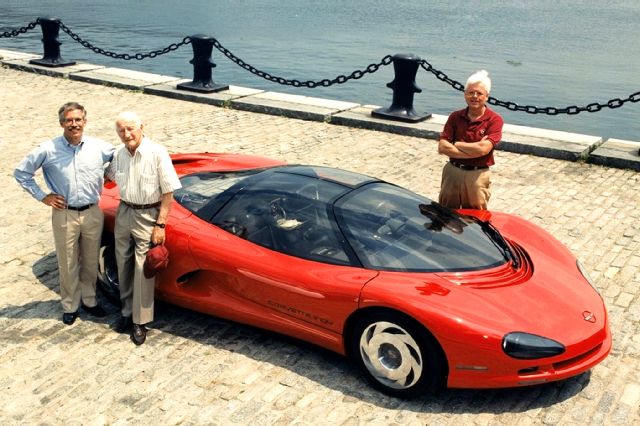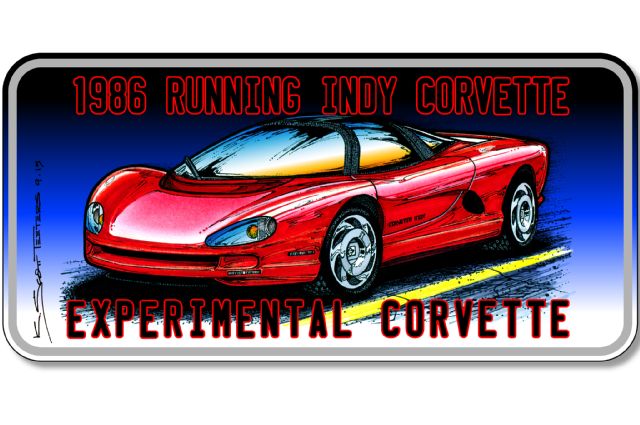
by K. Scott Teeters as republished from Super Chevy
Excerpted from: Trend Setting, Part 13: A look back at Chevrolet’s experimental,
prototype, concept car, and show car Corvettes
Dateline 12.2.15: After seeing the fullsize Corvette Indy clay model, GM brass approved the construction of two running prototypes of the bold new design. Now it was time to make the Corvette Indy run. The clay models were a little over the top and needed to be pulled back, but the running Corvette Indy still sizzled. Chevrolet’s Advanced Vehicle Engineering had their Corvette work cut out for them because a more realistic version of the Corvette Indy was being build at the same time. This realistic version would become the CERV III.
To understand the purpose of the Running Corvette Indy/CERV III program, two key elements have to be considered. First, GM had recently purchased Lotus and was anxious to use Lotus’ experimental “active suspension” concept in a high-profile car such as an advanced Corvette concept car. This would help showcase Lotus’ skills and abilities. Second was the next wave of electronic computer-control systems for cars. We’ve come so far in 30 years that we have to stop and remember that in the mid-’80s things such as drive-by-wire, active suspensions, electronic traction-control, antilock brakes, satellite-based navigation systems, and carbon-fiber body parts were just futuristic dreams. The base model C7 Corvette is all that and more. It had to start somewhere and this was the beginning.

Art by K. Scott Teeters
The overall design shape and hardware specifications came from the Corvette design team. Since GM had recently purchased Lotus, it was decided to use Lotus’ suspension engineering skills to develop a prototype active suspension system. And finally, Cecomp, in Turin, Italy, was contracted to assemble the finished running vehicle.
The had to be pulled in and pushed here and there. The front end was shortened and the A- and B-pillars were thicker and more realistic. Extra ground clearance and wheel travel in the wheel openings was added and fixed headlights behind clear plastic covers were used. But the shape, flavor, style, and attitude of the Corvette Indy remained. The headlights look a lot like those on the C6.
Corvettes have always been about “what’s under the hood.” The Corvette Indy project started out a few years before, when Corvette engineers wanted to do something with the intercooled twin-turbocharged, 2.65-liter Chevrolet IndyCar engines. The finished engine used in the running Corvette Indy was rated at 600-horsepower. Production Corvettes from 1985 to 1987 had 230-240-horsepower. Placement was not only mid-engine (something that Duntov wanted for decades), but was also transverse mounted, just like the 1970 XP-882. The backbone chassis was made of carbon fiber rather than the Kevlar tub of the first version. Microprocessors and hydraulics replaced the entire standard suspension. The car had fulltime, four-wheel drive, four-wheel steering, ABS brakes, and traction control. The active suspension allowed for smaller wheelhouses, fewer parts, and more interior room.
The interior of the running Corvette Indy had some interesting features. The climate and audio controls were mounted on the door panel and the all-wheel-steering system was selectable. Another futuristic feature was the CRT-based instrument display and navigation screen. “CRT” stands for, “cathode ray tube” same as an old-style “tube” TV screen. The navigation screen, something we all take for granted today, was very ambitious because in 1986 global positioning satellite systems (such as OnStar) weren’t yet available for civilian use. All-wheel steering was a trend that came-and-went so quickly hardly anyone noticed or missed it.
At slow speeds, turning the front and rear wheels in opposite directions results in smaller turning-radius. At higher speeds, turning all four wheels in concert improves high-speed stability. But in the late ’80s when Honda and a few other car companies came out with four-wheel-steering systems they were complicated and sometimes produced unnerving handling.
Corvettes have long since been all about style, power, and performance, so with 600 horsepower on tap, the mind begs the question: how quick and fast? That question doesn’t have an answer. It seems that if the car was ever seriously tested, that data was never released. It’s more likely that the car was never tested for that kind of performance, considering the amount of R&D money that was poured into the two running Corvette Indy cars that were built. Although the car certainly looks the part of a Bonneville Salt Flats speed record car, the Corvette Indy’s purpose was to test advanced suspension and electronics.
The running Corvette Indy was filled to the brim with advanced automotive technologies that today are standard features on not just Corvettes, but even entry-level cars. As a prototype, the running Corvette Indy was a success! The next stage would be the production-like CERV III.
